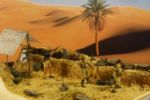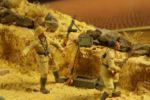(ita/eng)
Si è pensata questa scenetta per utilizzare figurini di Bersaglieri con il casco coloniale e fez, ritrovati in una scatola Italaerei dei primi anni ’70 e riconoscibili dall’approssimazione delle sembianze, se paragonate ai figurini di produzione odierna.
Il Reggimento “Giovani Fascisti”, tutti volontari provenienti dai GUF, crearono imbarazzo nell’Esercito, che non sapeva come inquadrarli ed adoperarli.
Mandati comunque al fronte, difesero con le unghie e con i denti la collinetta di Bir-el-Gobi contro la 7° Armata Indiana ed i Cameronians scozzesi.
Bir el Gobi era un importante crocevia per le carovane, nonché ultimo caposaldo della linea dell’Asse nell’entroterra. Per questo motivo i britannici lo reputavano, a ragione, il baluardo da superare per poter aggirare e intrappolare le truppe italo-tedesche e, conseguentemente, liberare le forze alleate che difendevano Tobruk.
Il Rgt., assieme a pochi altri reparti, resistette vittoriosamente per quattro giorni in condizioni di netta inferiorità. Alcuni carri leggeri L6 e due M13 furono interrati ed usati come postazioni mobili di mitragliatrici.
Tipico dei volontari del Rgt. GG.FF. era il rifiuto di usare l’elmetto, una sorta di spavalderia giovanile.
“Giovani Fascisti” (Young Fascist) Rgt. – Bir el Gobi, dec. 3-7, 1941
The idea was to adapt some Bersaglieri figures (same dress and hat), found in an old Italaerei box of years ’70. Easy to recognize their age, due to the poor definition when compared with recent production.
The Giovani Fascisti Rgt. consisted of volunteers of the university organization of the Fascist Party. They become soon an embarassing unit, as the HQ was unwilling to use them.
Sent to the front anyhow, they defended tooth and nail a small hill, Bir-el-Gobi, against the 7th Indian Army and Cameronians.
Bir-el-Gobi was an important caravan crossroad, as well as the last Axis stronghold in the hinterland. Fot this reason it was rightly considered by the British a point to be surpassed to get around Axis troops, to join and free the Tobruk defenders.
The Giovani Fascisti Rgt., together with few other troops, resisted bravely even being in strong inferiority. Some light tanks L-6 and two medium tanks M-13 were buried as used as machine-gun posts.
Typical of these volunteers, a sort of youth boldness, the refusal to wear the steel helmet.



